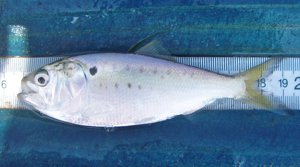Frequently Asked Questions
What are menhaden?Atlantic menhaden (Brevoortia tyrannus) are small (maximum length = 15 inches), schooling fish related to herring, shad, and sardines. Menhaden play an important ecological role in Chesapeake Bay by consuming large quantities of phytoplankton and zooplankton, and are themselves a favorite food of striped bass, bluefish, sea trout, tunas, sharks, and sea birds. The species inhabits near-shore waters along the Atlantic seaboard from Nova Scotia to Florida. 
Menhaden spawn in Chesapeake Bay from March to May, and again in September and October. Larvae use brackish and fresh waters as nursery areas, where they metamorphose into juveniles and grow rapidly. Menhaden are common in all salinities of Chesapeake Bay during the spring, summer, and fall, swimming in large schools close to the water’s surface. The young-of-the-year leave Chesapeake Bay in late fall and join schools in southward migration. During the fall and early winter, most menhaden migrate south to the North Carolina capes, where they remain until March and early April. |
Are menhaden stocks overfished?Based on a 2003 stock assessment by the Atlantic States Marine Fisheries Commission (ASMFC), the 2002 population-fecundity estimate of Atlantic menhaden was above the threshold and the estimated fishing mortality rate was below the threshold. Consequently, ASMFC concluded that the Atlantic menhaden stock in 2002 was not overfished and that overfishing was not occurring on a coast-wide basis. This assessment was conducted under the assumption that the Atlantic menhaden resource comprises a single unit stock throughout its range along the U.S. East Coast. Currently, there is a lack of reliable data to evaluate fishery impacts on finer spatial scales; hence, it is not possible to directly determine if within-season depletion is occurring in Chesapeake Bay. Reviews of existing biological and ecological data indirectly support the notion that menhaden abundance in Chesapeake Bay is low. Recruitment indices of young-of-the-year menhaden have chronically declined over the past two decades. Recent analyses of stomach contents of predatory finfish in Chesapeake Bay (i.e., striped bass, bluefish, and weakfish) show that menhaden comprise a conspicuously low percentage of their diets. Predation impact by recovered populations of seabirds also remains poorly understood. |
What is the status of the menhaden fishery in Chesapeake Bay?Since the early 1990s, the Atlantic menhaden reduction fishery has consolidated considerably; fleet size has decreased from approximately 19 vessels to 10 and currently only one fish-processing plant now operates in Reedville, VA. Although total landings associated with the reduction fishery reflect this decrease in effort (since 1990, landings have declined from approximately 400,000 t to 171,200 t), fishing activities have become more concentrated inside Chesapeake Bay. Due to this concentrated harvest, the potential for localized depletion of Atlantic menhaden from Chesapeake Bay now exists. |
Are menhaden stocks locally depleted in Chesapeake Bay?It is the general position of VIMS that there is currently insufficient direct evidence to indicate that localized depletion of menhaden from Chesapeake Bay has occurred. Hence, we do not support the implementation of drastic management regulations for the menhaden fishery. However, sufficient ancillary information regarding the possibility that menhaden abundance in Chesapeake Bay is quite low exists and warrants serious consideration. |
What is the current regulatory status of menhaden?In August 2005, the Atlantic States Marine Fisheries Commission (ASMFC) approved Addendum II to Amendment 1 to the Interstate Fishery Management Plan (FMP) for Atlantic menhaden (Brevoortia tyrannus). This document was developed in response to concern about the status of the Atlantic menhaden stock and contained a series of new management options for Atlantic menhaden currently under consideration by the ASMFC. Addendum II established a five-year annual cap of about 230 million pounds (104,326 metric tons) on reduction fishery landings in Chesapeake Bay, based on the mean landings over the previous five years. Over-harvest in any given year would be deducted from the next year's quota. Any amount of under-harvest would not be transferred to the next year. The cap was to be implemented beginning in 2006, but was not enacted by the Virginia General Assembly during its 2006 session. In August 2006, the ASMFC accepted a compromise cap (labeled Addendum III) that was presented in July by Virginia Governor Timothy Kaine. This cap is based on a five-year average ending in 2005, and allows a commercial harvest of approximately 240 million pounds (109,020 metric tons) annually through 2010. Over-harvest in any given year is deducted from the next year's quota. Addendum III also includes a provision allowing under-harvest in one year to be credited only to the following year's harvest, not to exceed 270 million pounds (122,740 metric tons). |
What is the status of menhaden research in Chesapeake Bay?The paucity of reliable data to evaluate localized depletion of Atlantic menhaden from Chesapeake Bay prompted the Atlantic Menhaden Technical Committee to develop the following list of research priorities. Each of these are currently ongoing at VIMS:
|
